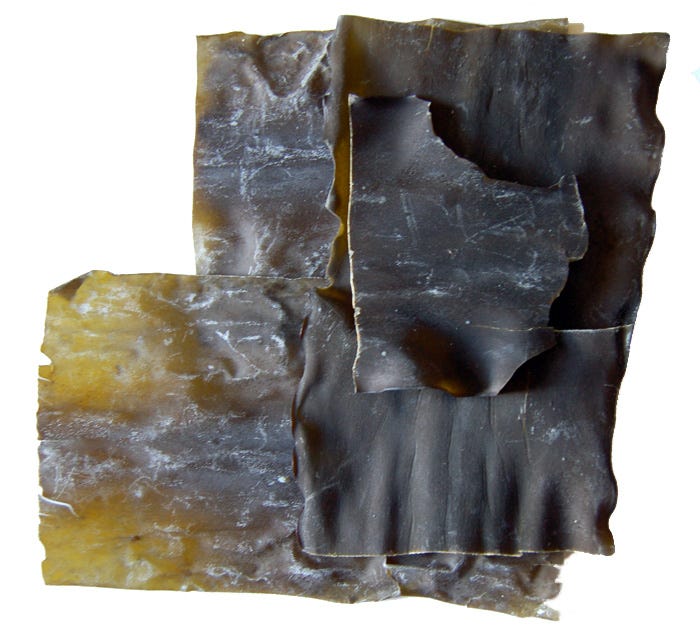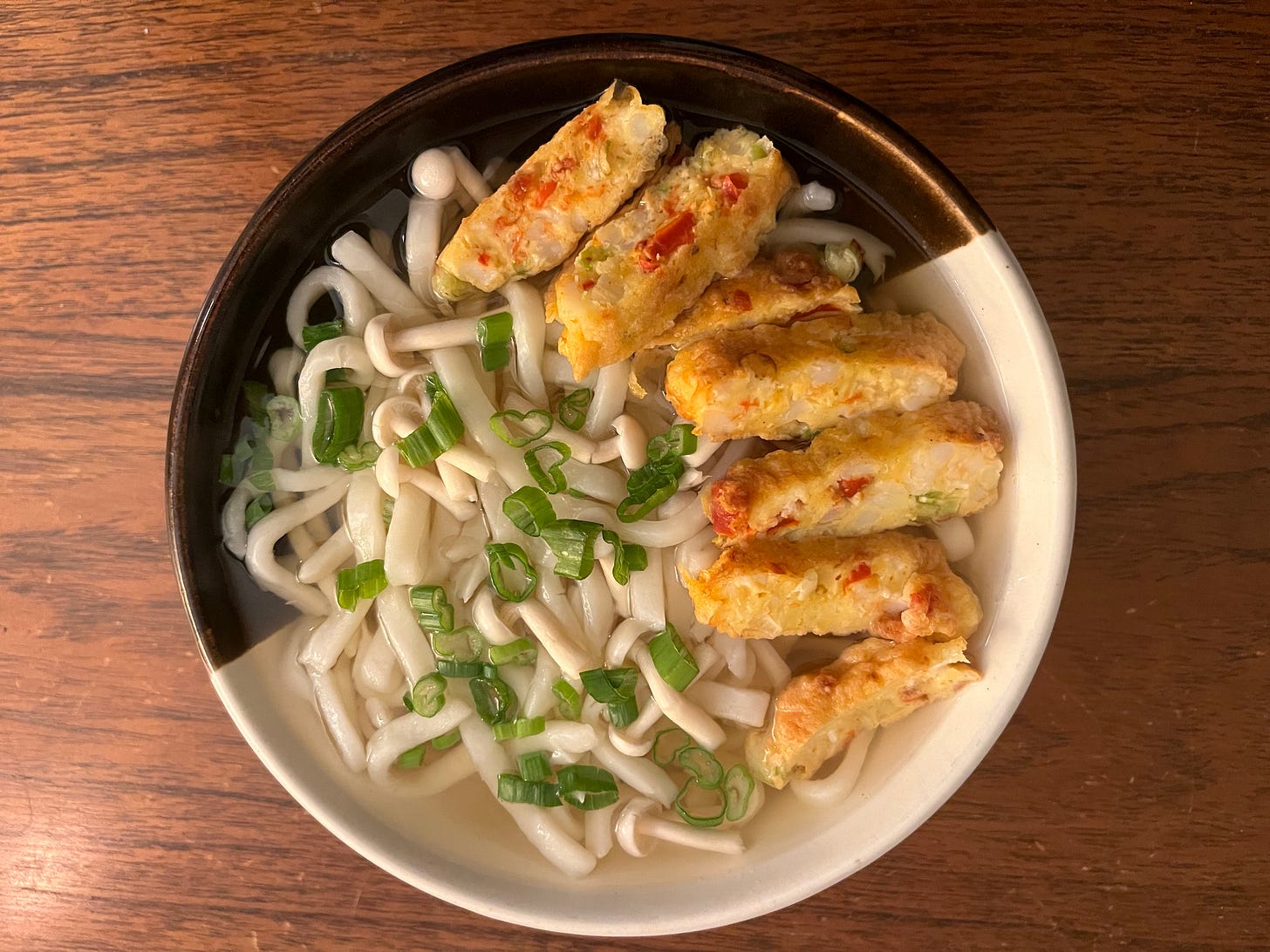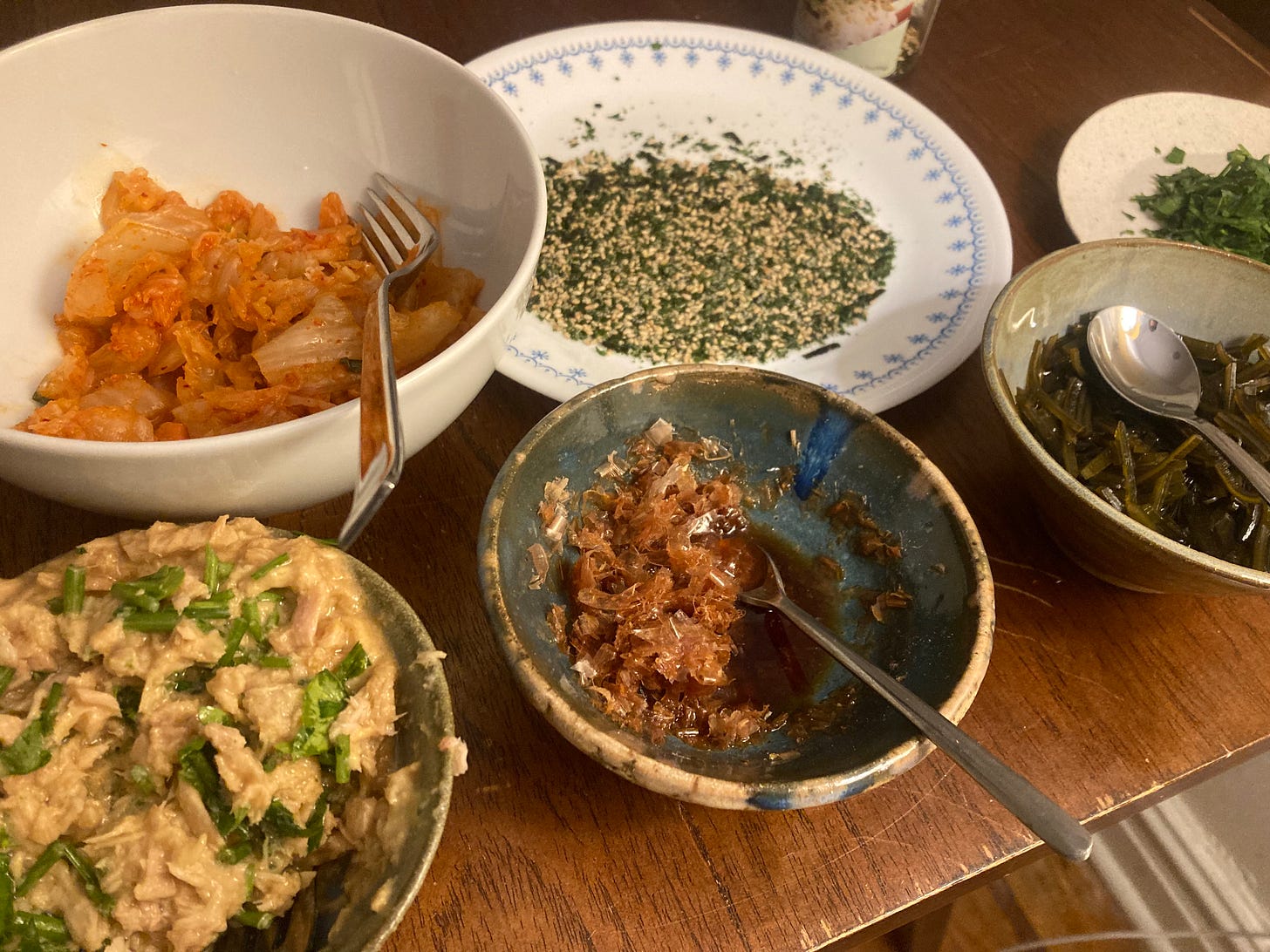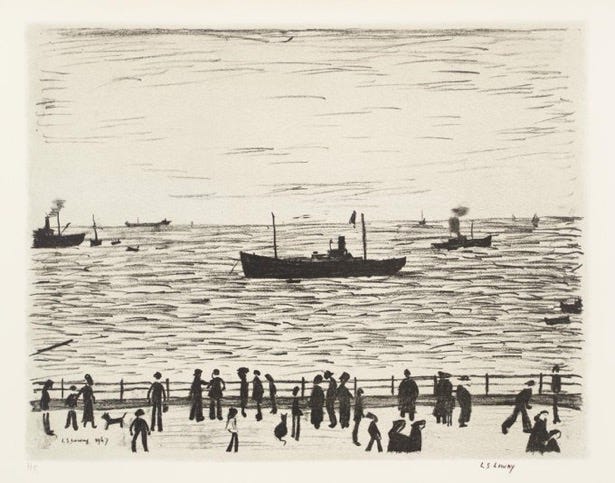The longest stretch of winter (or at least the one that feels the longest) is here for those of us who live in the northern hemisphere, and while the days are slowly growing longer, we have bleak February around the corner, a short month that can feel endless. There are no major holidays remaining; everybody’s jacket takes up too much space on the subway. Now begins a slow, agonizing build-up towards busy springtime things.
Today’s newsletter offers two remedies for winter madness. The first is an imploration to get outside, to the water, and the second is a set of recipes involving dashi, a nourishing fish broth that has completely changed my winter cooking routine in the last few years. I’ve included throughout some paintings by British artist L.S. Lowry that (to me) capture the gloomy, wintry vibe of some of the post-industrial outdoor areas that tend to be great places to see wildlife.
As far as the exact ratio of indoor/outdoor time you allot for yourself in these cold months, you’re on your own. Neither of these coping strategies is meant to be a totalizing world view about how to live, and just like everything in nature and in human life, avoiding winter gloom is a balancing act. We all need sunlight and outside time, just as we all need nourishment (soup). I hope this newsletter helps you strike the balance between indoor coziness and outdoor adventures.
Get to the Water:
There’s a common misconception, I think, that oceans and estuaries are somehow slower in winter than they are the rest of the year, but that’s not really true. The beachside stands are closed, sure, and all but the hardiest of us decline to swim (I went in, very briefly, on New Year’s Day), but just a glance at those places this time of year can be invigorating. Sure, our piping plovers are down in warmer climes, and the dolphins and sharks have mostly gone south, but from Maine down through the Chesapeake Bay, harbors and coastlines along the East Coast of the United States are jam-packed with life that’s fleeing even colder latitudes than ours.
Winter is a busy, frantic time for lots of animals and out offshore there’s a kind of energetic water-world that surprises some people! There’s wildlife traffic, with little penguin-like murres and razorbills paddling down the coast, and fish swirling around.
A lot of it is birds. As northern coasts become windier and rougher, and lakes up there seal over with ice, waterbirds come south. Go to the water’s edge and you you’ll see colorful winter ducks, loons, grebes, and gulls. They bob along the edges of jetties, diving and poking around for invertebrates and fish. There are mergansers, buffleheads, goldeneyes, and pintails around me. On the right day, on the right waterway, you can watch thousands of snow geese pour out of the sky, black wingtips flickering against gleaming white bodies.
I’ve articulated some version of this in previous letters but: you don’t need to be a “birder” or an amateur naturalist or whatever to enjoy this stuff! In fact, I think that sometimes the more driven, experienced “nature watchers” or whatever you want to call us can miss the forest for the trees, trying to eke out an extra bird species or two when we could be admiring the broader, raucous assembly of life. Winter is a great time for that kind of big picture reflection. Many of the birds you’ll see on the water are courting each other ahead of the breeding season, and all of them are trying to survive the same weather that sends us inside for soup. They’re fun to watch out there, searching for sunlight, food, and relief from the wind.
A lot of these animals have it better than you’d think, too. Huge schools of menhaden are still swimming around offshore, and Atlantic herring are wheeling in to shoal and spawn. In Canarsie and Jones Beach and you’ll see people from all over the world hanging out on the piers to catch the latter, taking the fish home fish to pickle them, salt them, or use them as bait in the spring.
The microscopic world of oceans and estuaries has its own fascinating winter cycles, too. When the water temperature drops enough, filter feeders such as clams, barnacles, mussels, and oysters enter states of torpor, slowing down their metabolisms and essentially hibernating. Meanwhile, the days start getting longer, and even though the temperature is still dropping, the little sunlight hungry things that feed the planet (phytoplankton) take notice. Basically, the math that controls plankton populations changes dramatically: there’s more light for the little plants, and fewer predators. It’s been a while since I dragged a plankton net or made a slide, and every year is different, especially in our strange, unpredictable climate, but plankton populations tend to explode in New York Harbor right about now (late January).
Plankton isn’t something you can easily see on a walk, but if you’re in NYC, there are plenty of organized tours available to you if you want to get out and see some of that winter wildlife with a guide. I’m partial to the ones I lead, which are mostly winter boat trips with Classic Harbor Line right now. These depart from Chelsea Piers and travel out past the Verrazzano Bridge to look at seals and seabirds on some islands in the Upper New York Bay. Last week, I tagged along with Gabriel Willow as he led one of his last ones of the season and we saw around 30 harbor seals, as well as scoters, mergansers, gulls, and a handful of other waterbirds. My first one is tomorrow at 9:00 AM, and then beginning on Sunday, they’ll be every Sunday and Friday through the winter.
You can pick up tickets for those right here! (If you do plan on coming, please use that link, which is associated with me/helps keep track of bookings I send to Classic Harbor Line).
I’m also leading a free bird walk for NYC Bird Alliance with Friends of the East River Esplanade this Saturday, meeting in Andrew Haswell Green Park at 60th Street and the East River Esplanade at 11:00 AM. I can’t promise any individual bird species, but we’ll gaze out at the cold water and look for ducks and other winter wildlife.
THE ABOVE INFORMATION IS AN ERROR! THE WALK IS AT THE SAME TIME AND PLACE, BUT THE FOLLOWING DAY (SUNDAY)- IT WILL BE LED BY THE EXCELLENT TOD WINSTON AND NOT BY ME. APOLOGIES—I’LL SEND OUT A CORRECTION TOMORROW MORNING
NYC Bird Alliance, my sometimes employer, also has a whole host of other great guides who are doing programs out at local shorelines for the next few months. You can see the full calendar for those here.
Another resource that’s really excellent is Sabrina Imbler’s newsletter Creatures of NYC. Sabrina is an excellent writer on all things ocean and nature related, and they’re much more diligent than I am about making sure to list each and every nature walk scheduled for the upcoming month.
To my non-NYC subscribers: I apologize again, for the local focus. As Popeye says: I Yam What I Yam. I wish you the best exploring the icy waters near you! Now: soup!
Dashi
Dashi is a simple, clear fish broth that’s easy to make. Having it around allows you to create incredible soups, sauces, and rice dishes in a pinch. If you looked at my recipe for fish stock and thought “sounds like fun (for someone else),” dashi is your ticket to eating delicious, homemade seafood without getting blood and guts all over your kitchen. I almost always have a container of it in my freezer.
You may have guessed by looking at my name but I should say quickly that I’m not Japanese, or an expert on Japanese anything. I have broad interests when it comes to writing, art, movies, food, etc. There are plenty of Americans who are really into Japan, which makes sense to me. It’s a fascinating, rich culture with a long history. I’d like to go there someday, and I’m always happy to learn new things. But I’m not really one of those people, either. I know a little bit, some of it from books, or movies, but at the end of the day I’m just an average joe who takes his beer cold and his dashi hot. All of which is to say:
There’s a good chance that you, especially if you’re Japanese, know a lot more about this stuff than me! If I leave out something you feel is important, or write something you believe to be incorrect, I’d be grateful if you (politely) let me know!
You definitely don’t have to be some kind of expert to make delicious Japanese food! If I can do it, any slob can do it. This is easy cooking!
Dashi (or the most common type of dashi) has three ingredients:
-kombu, which is a type of kelp
-dried bonito flakes, and
-water
Like any stock or broth, it’s an infusion that you make by steeping everything in water.
Kombu has been eaten in Japan since before the birth of Christ, especially in Okinawa where it grew naturally along the coast. In the 1600’s, people started harvesting it in bulk, drying it out, and delivering it everywhere else, which is probably around when dashi became popular.
In present day Japan, most people use instant dashi, which is a powder that you can just add to hot water. I’ve also seen a dashi “tea bag” type thing, where you just drop it in the hot water and leave it there. That said, making it from scratch is pretty easy, and I find it satisfying. Landlubber is all about restoring our connection to the ocean, and while I’m not going to tell you to go catch bonito yourself, or to harvest your own kelp, I do encourage you to grab some bonito flakes and kombu at a local grocery store and make it the old fashioned way, at least once.
How I Make Dashi:
Kombu comes dried, either as one large piece that’s folded up several times, or a few smaller pieces. It has a bunch of white stuff on it that sort of looks like dirt or grime, but it’s actually just the dried up residue from seawater (salts, minerals, sugars, and all kinds of things that end up imparting flavor and health benefits). Don’t rinse this off!
Place the kombu in a big pot of cold water (5-6 quarts), and leave it for about an hour or so. Then, turn the stove on and bring it to a simmer. Once it’s bubbling, add a half-cup of bonito, stir a couple of times to let it melt in, and then turn off the heat and let it sit uncovered for 5-10 minutes. Strain the seaweed and the bonito out with a mesh strainer. You’ll have 5-6 quarts of light brown liquid, which is dashi.
If you’re not using it right away, let it cool down before covering it and putting it in the fridge, where it will keep for 3 or so days, or the freezer, where it will keep for months.
What follows here is what I’m going to call “lazy recipes” where I tell you how to make different things with your dashi without giving much guidance on quantities or timing or anything like that. Basically, each recipe is a paragraph or two with broad instructions. The idea is to keep the body of this letter uncluttered and also to encourage you to have fun and do your own thing in the kitchen, which is my own deeply-felt value when it comes to cooking. This is especially easy with these soups, because it’s all about adding ingredients to simmering dashi, and it doesn’t matter much in most cases when or how you do that.
Making Your Own Dashi Based Soup:
Once you have dashi, you can simmer it and add whatever you want, but there are some ingredients that I’ve found to be particularly delicious. It’s common to add mirin, rice vinegar, sake, and/or soy sauce (usually a tablespoon or two of each, tasting along the way and adding as needed). Sometimes I add a squeeze lemon or lime, although that can cloud it up.
I’ve been ignoring instructions to remove oil or fat from the things I cook my entire life, but dashi is different: it’s a very simple, clean broth, and oil kind of undermines that quality. I would be lying if I said I never added chili crisp to any of these dishes, or slipped a fried egg on top of them, but if you can avoid putting a ton of the oil in (scoop as much dry sediment from the bottom of your chili crisp as you can) it pays. If you’re planning to cook anything in oil on the side and then add it on top, it’s also a good idea to pat it down as best you can.
Ingredients that i like to simmer in the soup: corn, enoki mushrooms, chopped bok choy, scallion whites, clams
Ingredients I like to toss on top uncooked at the last second:
Scallion greens, diced peppers, dried seaweed, eggs (a chopped mini omelet is great, as is a fried or soft-boiled egg)
Fish/shrimp: you can cook these in the broth if you want but I like to dust seafood with flour or drench it in chili paste and cook it on high so they get crispy, then place them in each bowl at the last moment. Frozen shrimp and fish are, as I’ve said before, fine, but just make sure you thaw and dry them completely, especially if you’re just going to simmer them in the soup.
Noodles: I usually cook noodles separately and then add them to the bowl before I put the broth on. Ramen, udon, and rice noodles all go great.
Miso Soup
Simmer dashi, add tofu, dried wakame seaweed, small mushrooms, chopped scallion whites. If you want to add fish or shrimp or something, either pat it completely dry and toss it in, or cook it separately in a hot pan. If you do the latter, make sure you pat as much oil off as you possibly can, and add it to the bowl at the last second. If you want rice noodles, or soba noodles, cook them separately, strain them, and add them to the bowl before you add the soup. Add white or yellow miso at the end while the broth is still simmering, or just place miso on the side with a spoon and let people add it themselves to taste.
Kake Udon
Simmer dashi, add soy sauce, mirin, sake, and rice vinegar to taste (a tablespoon or two of each is fine). Add the udon to the simmering dashi (or cook noodles separately, strain them, place them in bowls, and pour broth over). I often add some very simple fried shrimp cakes that I make with chopped shrimp, flour, eggs, spicy red pepper, and chopped scallion whites (the version pictured below has these and enoki mushrooms). Top with chopped scallion greens.
Rice1 and sides:
Rinse the rice in a metal bowl, adding cold water and then draining it out repeatedly as you run your hands through the rice. Initially, the water will get cloudy but eventually, if you keep doing it, it should run clear. Once it’s clear, drain it, fill the bowl up with the exact amount of dashi you’re going to use to cook the rice (10 ml of rice to 10.1 ml of dashi ratio), pour it into a pot, and let it soak for at least 20 minutes.
Then, bring the rice to a boil, turn the heat to a simmer, and cook for 12 minutes.
If you’re serving the rice as a side, scoop it into a bowl. Rice cooked with dashi goes really nicely with vegetables that have been blanched and then dressed in a sauce made of dashi, light soy sauce, vinegar, and chili crisp or chili oil. It would also go nicely with any number of simple fish or shrimp dishes, but I’m not including any of those in this letter.
Onigiri:
Onigiri are Japanese rice balls with fillings, and they’re pretty easy and fun to make. This is a great meal to make with leftovers, especially if you have plans to get outside in the next couple of days. Once your rice is finished and cooled just enough so it won’t burn you if you handle it, wet your hands in cold, salted water, spoon a small scoop of rice into your palm, add some filling, and then take another scoop of rice, slap it on top, and seal it shut by squeezing it in your hands.
Some of my favorite fillings are:
Bonito flakes: take some bonito flakes, mix them in a bowl with a little soy sauce, dashi, and rice vinegar. Sprinkle a little parsley on as you spoon them into the onigiri’s center.
Kombu: Once you’ve made your dashi, you can simmer the leftover kombu to make a delicious onigiri filling. Rinse it first, then take a sharp knife and slice it into the thinnest possible strands (at least as thin as spaghetti, but if possible, they should be so thin that they’re slightly translucent). Chop the strands into 1-2 inch pieces and simmer them in a small saucepan in soy sauce, mirin, dashi, and rice vinegar until they’re tender and delicious.
Tuna “salad:” there are probably as many ways to make tuna salad as there are mathematically possible games of chess. For onigiri, I confess, I usually just mix some mayo and sriracha with canned tuna and call it a day. You can add some chopped parsley stems for a crunch
Kimchi: I just strain it out of a jar and chop it up
Umeboshi (Japanese pickled plum): You’re going to want to buy these, but at some point next Fall, I promise to spend some time experimenting with beach plums and you’ll get a recipe using fruit that you can forage in maritime environments in the northeast.
Odds and ends: You probably have some stuff sitting around your kitchen that you like to cook with! I’m not your boss (In fact, if you pay for this letter, you’re kind of my boss.) I sometimes grate a carrot and marinate it in some rice vinegar and a little soy sauce. Other ideas: leftover roasted chicken, pickled vegetables, ham, spam, any kind of fish. If your fridge is just full of Diet Coke or whatever, and this is your first time cooking, go to a grocery store and walk around to get inspired. If you like to snack on something, it will probably make a good onigiri filling.
Finishing the Onigiri:
Onigiri are usually wrapped in nori: the thin, crunchy type of seaweed that comes on sushi. You can also use rice seasoning, sesame seeds, parsley, or crushed dried seaweed to give it a little texture. I usually try to stick a different garnish on the outside of each one, and wrap the seaweed a little differently so I can easily tell them apart. If you can, don’t put the nori on them until you’re ready to eat, or it’ll lose its crunch. If you’re packing lunch ahead of an outing and you don’t want the nori to get soft, you can stick it in a ziplock bag.
Alright, that’s all for this week! I hope you enjoy these soups, and take some nice walks along the water, and I look forward to seeing some of you on the seal trips this winter! I’ll have another letter coming soon.
Stay warm,
Russell
You’re going to want premium short or medium grain rice for this, which can be a little expensive. I promise it’s worth it. The only advice I can give you there is bargain hunt. I don’t know your grocery stores, but Garden Gourmet in Kingsbridge is pretty close to me, and they often have good deals. If you’re near a big Stop N’ Shop or something (aka in Rockaway or outside NYC) you can get lucky there, too. Good rice at H Mart is oddly expensive, I’ve found.









